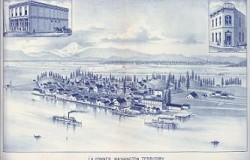La Conner history and heritage goes back thousands of years, the land on the delta near the mouth of the Skagit River has been home to the Swinomish Tribe. Since the early 1860’s it has also been home to La Conner, Skagit County’s oldest community.
Early settlers included many with names recognizable today such as Alexander Underwood, Michael Sullivan, Sam Calhoun and A.G. Tillinghast. In 1869, John Conner purchased the trading post, located on the west side of the Swinomish Slough and built by another early settler named John Hayes, and established a post office. In 1869, the town – plus 70 acres – was deeded to John Conner for $500. To honor his wife, Louisa A. Conner, the Town’s original name of Swinomish was changed in 1870 to La Conner. La Conner’s Civic Garden Club (still standing) was the first courthouse north of Seattle, and La Conner was briefly the county seat prior to moving the seat to Mount Vernon.
The early settlers diked hundreds of acres of land, creating farmland which would surpass per-acre yields around the globe. La Conner soon became a popular farm community and a hub for steamers carrying passengers and freight from Seattle. By the turn of the century, La Conner’s population had reached 1,000. La Conner was a thriving community due, in large measure, to its proximity to the water. Logging and fishing prospered until the depression.
Artists settled in the area in the 1940’s – renowned artists including Morris Graves, Guy Anderson, Richard Gilkey and Clayton James found the unique light and landscape an inspiration for much of their early work. Many of the leaders of the Northwest School of Art came from La Conner and the surrounding area. Through the years highly acclaimed artists have continued to call La Conner home and today La Conner is considered one of Washington State’s favorite communities for art lovers, and artists, alike.
In the 1970’s, La Conner became known as a ‘must-visit’ destination community and quickly thereafter was named one of the most romantic getaways in Washington State as well. Along with the tourists and weekend visitors, La Conner has become a haven for people seeking the peace and quiet of a charming and historic waterfront community.
Today you’ll find La Conner as picturesque as it was in the early days – many original buildings have been restored and now house retail shops, restaurants and museums. The town of La Conner and the Rainbow Bridge are listed on state and national historic registries; if you’re a history buff, La Conner’s Walking Tour of Historic Landmarks map is a great way to learn more about the early days of La Conner, as is a visit to the Skagit County Historical Museum.
For nearly 150 years, La Conner has had a special place in the hearts of its residents and visitors; we expect that it will continue to be one of Washington State’s most-loved historic communities for generations to come.

